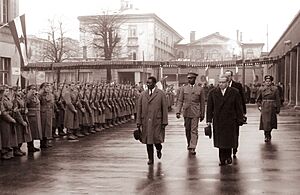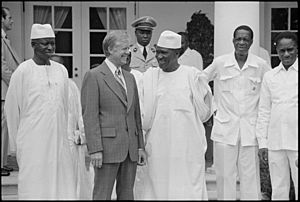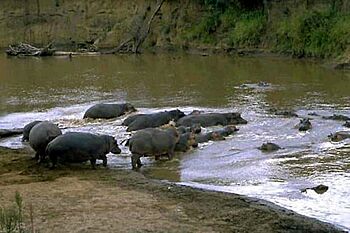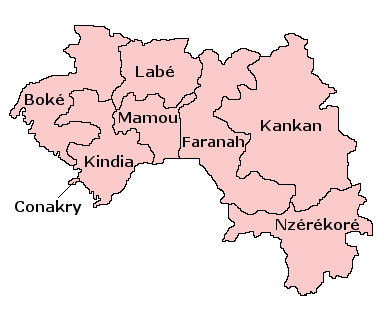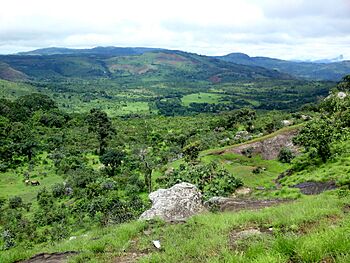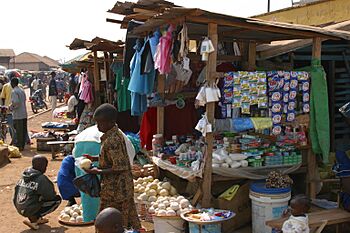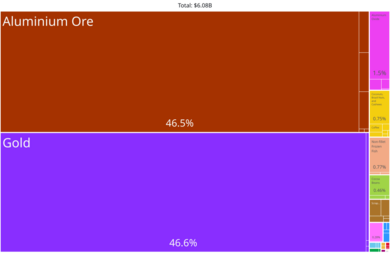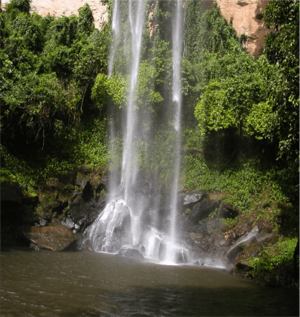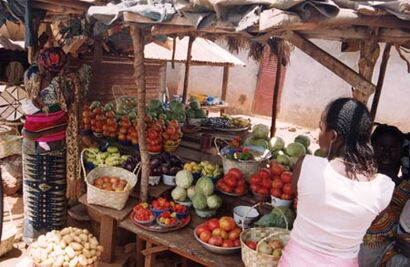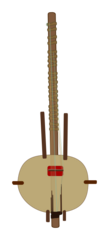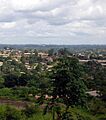Guinea facts for kids
Quick facts for kids
Republic of Guinea
République de Guinée (French)
𞤖𞤢𞤱𞤼𞤢𞥄𞤲𞤣𞤭 𞤘𞤭𞤲𞤫 (hawtaandi Gine) (Pular) ߖߌ߬ߣߍ߫ ߞߊ ߝߊߛߏߖߊߡߊߣߊ (Eastern Maninkakan) |
|
|---|---|

Guinea in dark green
|
|
| Capital and largest city
|
Conakry 9°31′N 13°42′W / 9.517°N 13.700°W |
| Official languages | French |
| Vernacular languages |
|
| Ethnic groups | |
| Demonym(s) | Guinean |
| Government | Unitary presidential republic under a military junta |
|
• Interim President and CNRD Chairman
|
Mamady Doumbouya |
| Bah Oury | |
| Legislature | National Council of the Transition |
| Independence
(was the colony of French Guinea since 1891)
|
|
|
• from France
|
2 October 1958 |
|
• Republic
|
2 October 1958 |
|
• 4th constitution
|
2 October 1958 |
|
• Second Republic Day
|
3 April 1984 |
|
• 2021 Guinean coup d'état
|
5 September 2021 |
| Area | |
|
• Total
|
245,857 km2 (94,926 sq mi) (77th) |
|
• Water (%)
|
negligible |
| Population | |
|
• 2024 estimate
|
13,986,179 (75th) |
|
• Density
|
40.9/km2 (105.9/sq mi) (164th) |
| GDP (PPP) | 2023 estimate |
|
• Total
|
|
|
• Per capita
|
|
| GDP (nominal) | estimate |
|
• Total
|
|
|
• Per capita
|
|
| Gini (2012) | 33.7 medium |
| HDI (2022) | low · 181st |
| Currency | Guinean franc (GNF) |
| Time zone | UTC (GMT ± 00:00) |
| Date format | dd/mm/yyyy |
| Driving side | right |
| Calling code | +224 |
| ISO 3166 code | GN |
| Internet TLD | .gn |
Guinea, officially the Republic of Guinea, is a country on the coast of West Africa. It shares borders with the Atlantic Ocean to the west, Guinea-Bissau to the northwest, and other countries like Senegal and Mali. Its capital city is Conakry, which is why it's sometimes called Guinea-Conakry to avoid confusion with other places named Guinea.
Guinea has about 14 million people and covers an area of 245,857 square kilometers. It used to be called French Guinea when it was a colony of France. Guinea became independent in 1958. After many years of rule by a single leader, it had its first democratic election in 2010.
Most people in Guinea are Muslim (90%). The country has four main geographic areas: the coastal area, the central highlands, the savanna in the northeast, and tropical forests in the southeast. While French is the official language, more than 24 local languages are spoken. Guinea's economy relies a lot on farming and mining. It is one of the world's biggest producers of bauxite, which is used to make aluminum. The country also has lots of diamonds and gold.
Contents
What's in a Name? The Meaning of Guinea
The name Guinea comes from the Guinea region in Africa. This region stretches from the Gulf of Guinea northwards through tropical forests to the Sahel. The English word "Guinea" comes from the Portuguese word Guiné. This word was first used in the mid-1400s to describe the lands where black African people lived south of the Senegal River.
In 1978, the country's official name changed to the People's Revolutionary Republic of Guinea. Then, in 1984, after the first president, Ahmed Sékou Touré, passed away, it was renamed the Republic of Guinea.
Guinea's Journey Through Time
The area that is now Guinea was once part of powerful African empires before the French arrived in the late 1800s. Guinea gained its independence from France on October 2, 1958. For many years after independence, Guinea was led by rulers who had strong control over the country.
Ancient Empires and Kingdoms
The land of Guinea was on the edge of several important West African empires. The Ghana Empire was one of the earliest, growing rich from trade. Later, the Mali Empire became powerful around 1235. Its rulers were called Mansa (Emperors). One famous Mansa was Kankou Moussa, who made a famous journey to Mecca in 1324. After his time, the Mali Empire slowly became weaker.
The Songhai Empire grew strong around 1460. It thrived until a civil war in 1582 caused it to decline. The empire was later taken over by invaders from Morocco in 1591. After these large empires, smaller kingdoms formed in the area. For example, Fulani Muslims created an Islamic state in Futa Jallon from 1727 to 1896. The Wassoulou Empire (1878–1898) was led by Samori Toure in what is now upper Guinea.
Becoming a French Colony
European traders started coming to the Guinea coast in the 1600s. France began to take control of the area in the mid-1800s. After defeating the armies of Samori Touré in 1898, France gained full control of what is now Guinea.
France then worked with Britain, Portugal, and Liberia to set the borders of Guinea. Under French rule, Guinea was part of French West Africa. It was managed by a governor general in Dakar, with a lieutenant governor in charge of Guinea itself.
In 1958, France offered its colonies a choice: either become self-governing within a new French Community or gain immediate independence. Guinea voted strongly for independence on September 28, 1958. This decision was led by Ahmed Sékou Touré, whose party had won most of the local elections.
The French then left Guinea. On October 2, 1958, Guinea declared itself a free and independent republic, with Sékou Touré as its first president. There were even secret plans by France to try and harm Guinea's economy, but these plans were discovered.
After Independence
Under President Touré
In 1960, President Touré made his party, the Democratic Party of Guinea, the only legal political party. For the next 24 years, the government and the party were essentially the same. Touré was re-elected president several times without anyone running against him.
In 1970, forces from neighboring Portuguese Guinea launched an attack on Conakry. One of their goals was to capture or harm Sekou Touré because he supported a group fighting for independence in Portuguese Guinea. The attackers eventually retreated.
In 1977, due to economic problems and rules against private businesses, women in Conakry's markets started protests. These were known as the Market Women's Revolt. Towards the end of his rule, Touré made some economic changes. Trade with France also increased.
Under President Conté
Sékou Touré passed away on March 26, 1984. Soon after, Colonels Lansana Conté and Diarra Traoré took power in a peaceful takeover. Conté became president.
President Conté spoke out against the previous government's human rights record. He released many political prisoners and encouraged Guineans who had left the country to return. He also moved the country away from socialist policies. In 1992, Conté announced that Guinea would return to civilian rule. A presidential election was held in 1993, followed by parliamentary elections in 1995.
In 2001, President Conté held a vote to extend the presidential term, and he won. He began his third term in 2003, though many opposition parties did not participate in the election.
Around 2000, Guinea faced problems with conflicts near its borders with Liberia and Sierra Leone. Some people worried the country might fall into civil war. In 2003, Guinea agreed with its neighbors to work together to deal with these border issues. In 2007, a large strike led to the appointment of a new prime minister.
Guinea's Landscape and Nature

Guinea shares its borders with several countries: Guinea-Bissau to the northwest, Senegal to the north, Mali to the northeast, Ivory Coast to the east, Sierra Leone to the southwest, and Liberia to the south. The country is shaped like a crescent moon, curving from its southeast to its northwest coast on the Atlantic Ocean. Guinea is about the same size as the United Kingdom, covering 245,857 square kilometers. It has 320 kilometers of coastline.
The Guinea Highlands are home to the starting points of three major rivers: the Niger River, the Gambia River, and the Senegal River.
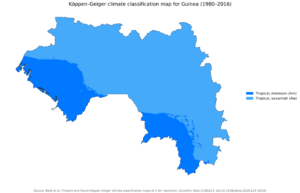
Guinea is divided into four natural regions:
- Maritime Guinea (also called Lower Guinea) is on the Atlantic coast.
- Fouta Djallon (Middle Guinea) is a cooler, mountainous area in the middle of the country.
- Haute-Guinea (Upper Guinea) is a savanna region in the northeast.
- Guinée forestière (Forested Guinea) is a jungle region in the southeast.
The highest point in Guinea is Mount Nimba, which is 1,752 meters tall. Part of the Nimba Massif is a UNESCO Strict Nature Reserve, protecting its unique environment.
Amazing Wildlife
The southern part of Guinea is a "Biodiversity hotspot" called the Guinean Forests of West Africa. This means it has many different kinds of plants and animals. The northeast has dry savanna woodlands. Some animal populations are decreasing and can only be found in remote parts of parks and reserves.
Some animals found in Guinea include:
- Amphibians like Hemisus guineensis and Phrynobatrachus guineensis.
- Reptiles such as Acanthodactylus guineensis and Mochlus guineensis.
- Insects like Zorotypus guineensis and Euchromia guineensis.
- Birds like Melaniparus guineensis.
Regions and Cities
Guinea is divided into 8 administrative regions. These regions are further divided into 33 prefectures. The capital city, Conakry, is a special zone with a population of over 1.6 million people.
| Region | Capital | Population (2014 census by National Institute of Statistics) |
|---|---|---|
| Conakry Region | Conakry | 1,675,069 |
| Nzérékoré Region | Nzérékoré | 1,591,716 |
| Kindia Region | Kindia | 1,573,690 |
| Boké Region | Boké | 1,092,291 |
| Labé Region | Labé | 1,001,392 |
| Mamou Region | Mamou | 737,062 |
| Kankan Region | Kankan | 1,979,038 |
| Faranah Region | Faranah | 949,589 |
How Guinea is Governed
Guinea is a republic. The president is chosen directly by the people and is both the head of state (the country's main representative) and the head of government (the leader of the government). The country has a single legislative body called the National Assembly, whose members are also elected by the people. The highest court in Guinea is the Supreme Court.
The president of Guinea is usually elected for a 5-year term. To win, a candidate must get more than half of the votes. The president leads the country with the help of a group of 25 civilian ministers whom he appoints.
Guinea's Economy and Resources
In 2018, it was found that 66.2% of Guinea's population was affected by multidimensional poverty. This means they lack basic things like health, education, and living standards. Another 16.4% were at risk of poverty.

Farming and Food
About 75% of the people in Guinea work in agriculture. Rice is a main crop, grown in flooded areas near rivers. However, Guinea doesn't grow enough rice for everyone, so it imports rice from other countries. Guinea is also starting to grow apples, pears, grapes, pomegranates, and even strawberries using modern farming methods.
Rich Natural Resources
Guinea has a lot of natural resources. It holds 25% or more of the world's known bauxite reserves. Bauxite is a rock used to make aluminum. The country also has large amounts of diamonds, gold, and other metals. Bauxite and alumina (which comes from bauxite) are Guinea's most important exports.
Mining Industry
Guinea has over 25 billion tons of bauxite, possibly up to half of the world's total supply. It also has more than 4 billion tons of high-quality iron ore, plus deposits of diamonds, gold, and uranium.
Mining bauxite and producing alumina are very important for Guinea's economy, bringing in about 80% of its foreign money. The Compagnie des Bauxites de Guinée (CBG) exports about 14 million tons of bauxite each year. CBG is a partnership between the Guinean government and an international group of companies.
Another company, Compagnie des Bauxites de Kindia (CBK), produces about 2.5 million tons of bauxite annually, mostly sent to Russia and Eastern Europe. The Alumina Compagnie de Guinée (ACG) produces about 2.4 million tons of bauxite and refines it into 750,000 tons of alumina.
The Simandou mine holds a huge amount of iron ore. Companies are planning to develop this mine and build a new railway and deepwater port to transport the ore.
Tigui Camara, a former model, is the first woman in Guinea to own a mining company.
Oil Exploration
In 2006, Guinea signed an agreement with Hyperdynamics Corporation to explore for oil offshore. They drilled a well in 2011, but it was not found to be commercially useful. In 2012, Hyperdynamics sold part of its share to Tullow Oil.
Tourism and Beautiful Sights
Guinea has many beautiful waterfalls, especially in the Lower Guinea and Middle Guinea regions. Some popular waterfalls include:
- The Soumba cascade near Mount Kakoulima in Kindia.
- The Voile de la Mariée (Bride's Veil) in Dubreka.
- The Kinkon cascades, about 80 meters high, on the Kokoula River in Pita.
- The Kambadaga falls, which can reach 100 meters during the rainy season.
- The Ditinn and Mitty waterfalls in Dalaba.
- The Fetoré waterfalls and a stone bridge in the Labe region.
Science and Technology
In 2023, Guinea was ranked 128th out of 132 countries in the Global Innovation Index. This index measures how well countries use innovation.
Getting Around: Transport in Guinea
Ahmed Sékou Touré International Airport is the largest airport in Guinea. It has flights to other cities in Africa and to Europe.
A railway line built between 1904 and 1910 used to connect Conakry to Kankan. However, it stopped working in 1995 and was later taken apart. There are plans to build new heavy-duty railways to transport minerals like iron ore from mines to ports. For example, a new 650 km railway is planned to connect the Simandou mine to a deepwater port at Matakong.
People and Culture of Guinea
| Population in Guinea | |||
|---|---|---|---|
| Year | Million | ||
| 1950 | 3.0 | ||
| 2000 | 8.8 | ||
| 2018 | 12.4 | ||
In 2021, Guinea's population was estimated to be about 13.6 million people. Conakry, the capital, is the largest city and a center for business, education, and culture. In 2014, the average number of children born per woman in Guinea was 4.93.
|
Largest cities or towns in Guinea
According to the 2014 census |
||
|---|---|---|
| Rank | Name | Pop. |
| 1 | Conakry | 1,660,973 |
| 2 | Nzérékoré | 195,027 |
| 3 | Kankan | 190,722 |
| 4 | Manéah | 167,354 |
| 5 | Dubréka | 157,017 |
| 6 | Kindia | 138,695 |
| 7 | Siguiri | 127,492 |
| 8 | Kissidougou | 99,931 |
| 9 | Labé | 92,654 |
| 10 | Kamsar | 83,428 |
Many languages are spoken in Guinea. The official language is French. In 2018, Pular was the native language for 33.9% of the population, followed by Mandingo (29.4%) and Susu (21.2%). Other native languages include Kissi and Kpelle.
Guinea's population is made up of about 24 different ethnic groups. The Mandinka (29.4%) live mostly in eastern Guinea. The Fulas or Fulani (33.4%) are mainly found in the Futa Djallon region. The Soussou (21.2%) live mostly in western areas around the capital, Conakry. Smaller ethnic groups make up the rest of the population. In 2017, about 10,000 non-Africans, mostly Lebanese, French, and other Europeans, lived in Guinea.
Religion in Guinea
| Guinea religious groups in 2020 | ||||
|---|---|---|---|---|
| Religion | Per cent | |||
| Islam | 86.8% | |||
| Traditional African religion | 9.42% | |||
| Christianity | 3.52% | |||
In 2023, data showed that 86.8% of the population were Muslims, 3.52% were Christians, and 9.42% followed traditional African religions. Both Muslims and Christians in Guinea have sometimes blended their beliefs with local African traditions.
Most Muslims in Guinea follow Sunni Islam. Christian groups include Roman Catholics, Anglicans, Baptists, Seventh-day Adventists, and Evangelical groups. There are also Jehovah's Witnesses and a Baháʼí Faith community. Among people from other countries living in Guinea, there are also Hindus, Buddhists, and traditional Chinese religious groups.
Education in Guinea
In 2010, it was estimated that 41% of adults in Guinea could read and write (52% of men and 30% of women). Primary school is required for 6 years. In 1999, only 40% of children attended primary school. Many children, especially girls, were kept out of school to help their families or get married. In 2015, Guinea had one of the highest rates of child marriage in the world.
Fun Facts About Guinea's Culture
Sports in Guinea
Football (soccer) is the most popular sport in Guinea, along with basketball. The Guinean Football Federation manages football in the country, including the national team and the national league. The national team, nicknamed Syli nationale (National Elephants), has played international matches since 1962. They have not yet reached the World Cup finals, but they were runners-up in the Africa Cup of Nations in 1976.
The top football league in Guinea is the Guinée Championnat National. Since it started in 1965, three teams from Conakry have won most of the titles: Horoya AC, Hafia FC, and AS Kaloum Star. Hafia FC won the African Cup of Champions Clubs three times (in 1972, 1975, and 1977), and Horoya AC won the 1978 African Cup Winners' Cup.
Delicious Guinean Food
Guinean cuisine (food) changes from region to region, but rice is a main food. Cassava is also eaten. Some common Guinean foods include yétissé, peanut sauce, okra sauce, and tapalapa bread. In rural areas, people often eat from a large shared dish using their hands.
Music and Instruments
The traditional musical instruments of Guinea are the drum, kora, bala, and koni.
Images for kids
See also
 In Spanish: Guinea para niños
In Spanish: Guinea para niños




